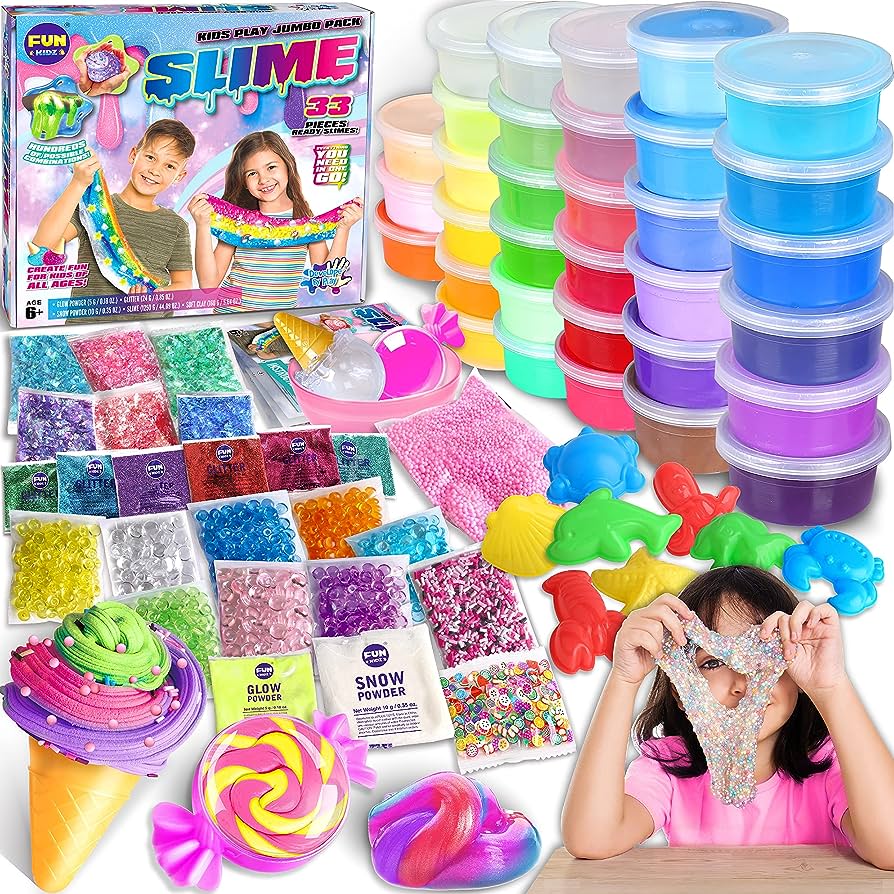Slime has become a popular toy for children, especially in recent years. It’s a fun and tactile material that can be stretched, squished, and molded into different shapes. However, slime is more than just a toy. It’s also a great way to teach children about science and chemistry in a hands-on and interactive way. In this article, we’ll explore the science behind slime, the benefits of educational slime kits for kids, and some fun and creative slime-making ideas to try at home.

The Science Behind Slime
Slime is a non-Newtonian fluid, which means that its viscosity (or thickness) changes depending on the force applied to it. When slime is left alone, it flows slowly like a liquid. But when it’s squeezed or punched, it becomes more solid-like and can even break apart like a solid. This unique property makes slime a great way to explore scientific concepts like viscosity, elasticity, and force.
Slime is made up of two main ingredients: a base and an activator. The base is usually a type of glue, such as school glue or clear glue. The activator is typically a solution of water and borax or contact lens solution. When these two ingredients are mixed together, they undergo a chemical reaction that causes the glue molecules to link together and form long chains. These chains are what give slime its stretchy and gooey texture.
The Science of Slime: Exploring Viscosity and Elasticity
One of the scientific concepts that can be explored through slime is viscosity. Viscosity is a measure of how thick or thin a liquid is. Slime’s viscosity changes depending on the force applied to it. When it’s left alone, it flows slowly like a liquid. But when it’s squeezed or punched, it becomes more solid-like and can even break apart like a solid.
Elasticity is another scientific concept that can be explored through slime. Elasticity is the ability of a material to stretch and then return to its original shape. Slime is highly elastic because of the long chains of molecules that make up its structure. When slime is stretched, these chains are pulled apart. But when the force is released, the chains snap back into place, causing the slime to return to its original shape.
The Benefits of Educational Slime Kits for Kids
Educational slime kits are a great way to teach children about science and chemistry in a hands-on and interactive way. These kits typically include all the ingredients and materials needed to make slime, as well as instructions and educational materials that explain the science behind slime.
One of the benefits of educational slime kits is that they can help children develop an interest in science and chemistry. By exploring scientific concepts like viscosity and elasticity through slime, children can gain a deeper understanding of these concepts and how they relate to the world around them.
Another benefit of educational slime kits is that they can help children develop problem-solving skills. Making slime requires children to follow instructions, measure ingredients, and experiment with different textures and consistencies. This can help children develop their critical thinking and problem-solving skills, which can be applied to other areas of their lives.
Finally, educational slime kits can promote creativity and sensory play. Children can experiment with different colors, textures, and glitter to create their own unique slime recipes. They can also explore the tactile properties of slime, which can help promote sensory development and fine motor skills.
Fun and Creative Slime-Making Ideas
Making slime doesn’t have to be limited to the ingredients that come in a slime kit. With a little creativity, you can come up with your own unique slime recipes and experiment with different textures and consistencies. Here are a few fun and creative slime-making ideas to try at home:
-
Glitter Slime: Add some glitter to your slime for a sparkly and fun texture.
-
Crunchy Slime: Mix in some foam balls or small plastic beads for a satisfying and crunchy texture.
-
Clear Slime: Use clear glue instead of white glue for a translucent and unique slime.
-
Metallic Slime: Add some metallic pigment or paint to create a shiny and metallic slime.
-
Fizzy Slime: Add some baking soda and vinegar to create a slime that fizzes and bubbles.
-
Butter Slime: Mix in some clay or model magic to create a slime that’s soft and buttery.
In conclusion, slime is more than just a toy. It’s a great way to teach children about science and chemistry in a hands-on and interactive way. Educational slime kits can help children develop an interest in science and chemistry, as well as problem-solving skills and creativity. With a little creativity, you can come up with your own unique slime recipes and experiment with different textures and consistencies. So why not grab some glue and activator and get started on your own slime-making adventure?